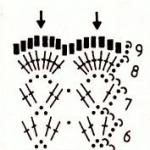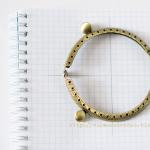One-piece sleeve with gusset. Pattern and sewing of a traditional Slavic shirt How to sew a gusset to trousers
Today we’ll talk about a one-piece sleeve with a gusset.
Gusset- this is an insert at the bottom of the conditional armhole of a one-piece sleeve. It compensates for the volume at hand of a one-piece sleeve of insignificant volume. The gusset allows you to make narrower, tighter products without limiting the freedom of hand movement.
Below we consider two types of gussets:
Gusset that allows the arm to be raised 180 degrees;
Gusset that allows the arm to be raised 90 degrees.
5. Trace the patterns and transfer the dart to the convexity of the shoulder blades to the back armhole. Transfer part of the chest dart solution to the front armhole. Align the cut lines.
6. Set aside 6.4 cm along the side sections of the back and front from the armhole downwards - point X.
7. Attach the back to the back of the sleeve, aligning the X points. In this case, the shoulder point of the back should be located on the horizontal guide - mark it with the letter A.
8. Repeat with the front of the sleeve and the front.
9. Draw a 9cm line from the X points in the direction of the armhole curve. Place points B.
10. Divide the segment of the horizontal guide between A in half - point Z.
11. At the bottom from the middle of the sleeve, set aside 2.5 cm to the right - point U.
12. Connect points Y and Z - the line of the upper seam of the sleeve is obtained. Cut the sleeve along this line.
13. Trace the divided patterns of the front with the front of the sleeve and the back with the back of the sleeve, do not forget about the lines of the gusset cuts.
14. Draw lines for the upper cuts of the sleeve parts, as shown in illustrations 5, 6.
Design of the gusset opening for a one-piece sleeve
1. On the front, from the gusset cut line in both directions, set aside 1.3 cm from point X (seam allowances).
2. Connect B with the right mark and extend the line to the side cut - point C.
3. Draw a line with a length equal to the length of the segment BC from B through the left mark - point D. Line ВD may not reach the longitudinal section of the front part of the sleeve.
4. From D, draw a longitudinal section of the front of the sleeve to the elbow.
5. Repeat all the steps to create the gusset cut on the back and back of the sleeve, using the value of the segment BC.
6. Add seam allowances along the edges.
Gusset for 180 degree arm lift
- Fold a piece of paper in half. In the middle, draw a segment 5 cm long at a right angle to the fold - point B.
- From B, draw a line upward until it intersects with the fold of the sheet with a length equal to the segment BC in the drawing of the front - point C. Similarly, draw a line BD with a length equal to the segment BC.
- Add 1.3 cm seam allowances, cut and unfold (Fig. 7).
Two-piece gusset: Divide the gusset in half lengthwise, add seam allowances and cut out of paper (Fig. 8).
Gusset for 90 degree arm lift
- Draw a 90 degree angle, the sides of the angle should be equal to the cut off BC on the front drawing.
- Draw a bisector of an angle 5 cm long.
- Draw a smooth curve from D to C.
- Add seam allowances and cut from paper.
Sewing a one-piece sleeve with a gusset
1. Cut out the details of a one-piece sleeve from the selected material.
2. Cut a square with sides of 2.5 cm from the adhesive pad and glue it at the end of the gusset cut line on the wrong side of the part.
3. Mark the seam lines (points D and C) and cut the one-piece sleeve pieces along the gusset opening lines.
4. Mark points B, C and D at each corner of the gusset (Fig. 2).
5. Stitch the side sections of the product and the longitudinal sections of the sleeves to points C and D; Press the seams (Fig. 3).
6. Sew the gusset side from D to B with bartacks at the beginning and end of the stitching (do not break the threads). In this case, the width of the seam along the gusset sections should be uniform along the entire length of the seam, and from the side of the sleeve part, the width of the seam smoothly decreases towards B.
7. Lower the needle at point B, turn the piece and stitch from B to C with bartacks at the beginning and end (Fig. 4). Connect the other half of the gusset in the same way.
8. Press or press the gusset seams.
Two-piece gusset
5. The gusset is stitched to the main parts of the product before the lower sections of the sleeves and side sections of the product are connected.
6. Sew the gusset parts to the sections of the main parts.
7. Sew the side sections of the front and back, the middle sections of the gusset parts and the longitudinal sections of the sleeve parts in one line.
8. Press or press seams.
One of the signs of high quality tights is the presence of a gusset.
The gusset is a diamond-shaped piece of fabric that is sewn into the crotch to provide strength to the product, greater width so as not to interfere with free walking, and reduce the stress of wearing tight tights, increase their hygiene, and prevent the appearance of odor. The gusset is usually made of breathable, porous cotton. It is believed that when wearing tights with a gusset, it is acceptable not to wear other underwear underneath.
Tights can have a positive effect on health: they keep you warm in cold weather, and in low humidity they protect your legs from drying out. Support tights help prevent the development of varicose veins in those who have to constantly be on their feet at work, and relieve pain by regulating blood circulation. Tights also reduce friction between the skin and shoes and prevent calluses and chafing. However, wearing tights may have some negative impact on the body, to avoid this, the gusset was invented. Its presence allows women not to fear for their health when using tights and not to give up the positive effects that it brings.
The presence of a gusset on tights is important for maintaining women's health for several reasons. For example, due to the fact that the tights are made of synthetic materials, they are able to accumulate bacteria and heat up in the genital area and therefore they can become a direct or indirect cause of the development of candidiasis. Women who have had vaginal yeast infections and are at risk of developing them are not recommended to wear synthetic products. If a woman does not like to wear stockings, having a gusset on her tights is a possible way out of this situation.
The warm, moist environment in the genital area created by wearing tights without a gusset can, in rare cases, also cause the development of fungal skin infections or aggravate the development of existing fungal and allergic diseases such as eczema or hives, leading to the appearance of a rash.
In addition, the presence of a gusset helps reduce the pressure of the tights on the urethra and remove moisture. This helps prevent various urethritis, which can sometimes be caused by wearing completely synthetic products. Therefore, our online store recommends that you buy tights with a gusset - it is safer for your health.
Taking care of you, online store of stockings and tights website.
This article belongs to the site www.site. When reprinting materials, a hyperlink to the site is required.
In any children's products with pants, be it just pants with an elastic band (strings) or overalls with buttons or straps, or overalls with a zipper or with straps, in the place where the fabric diverges into the legs, I always knit a gusset - this is an additional “piece” "-triangle, performed simultaneously with the main canvas and subsequently giving “freedom of movement” to the child.
After all, a baby’s legs never stand still, and even a newborn’s are often higher than his head…. Therefore, such a “trifle” as a gusset must be there - it’s very easy to do during the knitting process, but the main thing is to wear the panties comfortably, and not constantly sew along the seam or darn the resulting holes between the legs)))
VideoMK of gusset knitting technique (step bevel)
for three options for knitting children's items:
- When knitting a pattern from top to bottom
It is possible to knit a gusset or step bevel in 7-9 rows, depending on the thickness of the yarn. The height of the increases for the gusset is 2-4 cm, the number of rows of decreases is usually the same, then uniform single decreases along the entire length of the trouser leg are made to shape the trouser leg itself, but not to form the gusset. With thinner yarn, you can increase the number of rows of additions, while the knitting principle remains the same.
To calculate the starting point for knitting the gusset: from the waist line (belt, elastic drawstring on pants or the visual line of the middle of the overalls) down, measure the distance to the beginning of the division of the fabric into the legs. And from this parameter subtract the height of the gusset (2-4 cm indicated above). From this row you should start knitting the shs.
Approximate parameters for calculating the start of gusset knitting - according to the diagram

So, the fabric is knitted before the start of knitting the shs, then like this:
— if we knit a product with a fastener in the center of the front(overalls, bib overalls, pants with a fastener at the front)
in the last purl row Mark the center of the fabric along the back with a marker, then
1st row: chrome, knit a stitch according to the drawing until the penultimate stitch before the marker, from which knit 2 stitches from one, 1 stitch according to the drawing, transfer the marker to the right knitting needle, 1 stitch according to the drawing, knit from the next stitch 2 stitches from one, then knit all stitches according to the pattern until the end of the row
2nd row: all sts according to the picture
3rd row: chrome, 2 stitches from one, 2 stitches from one, then all stitches according to the drawing until the penultimate stitch before the marker, from which knit 2 stitches from one, 1 stitch according to the drawing, transfer the marker to the right knitting needle, 1 stitch according to the drawing, from the next stitch knit 2 stitches from one, then knit all stitches according to the drawing until the third stitch from the edge, from which knit 2 stitches from one, 2 stitches from one, 1 stitch according to the drawing.
4th row: all sts according to the picture
5th row: chrome, 2 sts from one, then all sts according to the drawing until the penultimate st in front of the marker, from which knit 2 sts from one, 1 st according to the drawing, transfer the marker to the right knitting needle, 1 st according pattern, from the next stitch, knit 2 stitches from one, then knit all stitches according to the pattern until the penultimate stitch from the edge, from which knit 2 stitches from one, 1 stitch according to the drawing
Remove the loops after the marker for extra. knitting needle, set aside knitting. Knit each leg separately.
Row 7 (purl): bind off 4 stitches at the same time, knit all stitches according to the pattern until the end of the row
Row 8: knit 2 stitches in, bind off 1 stitch, then knit all stitches according to the pattern until the end of the row
Row 9: knit 2 stitches in, bind off 1 stitch, then knit all stitches according to the pattern until the end of the row
The formation of the ShS is completed.
More details can be found in the photo of MK overalls HERE .
General view of the product


— when knitting a product in the round
in the last purl row, mark the center of the back and the center of the front with markers, then continue like this
1st row: knit to the penultimate stitch from the front center marker, from which knit 2 stitches from one, then knit 1, transfer the marker to the right knitting needle, knit 1, from the next stitch knit 2 stitches from one, then continue knit a row to the penultimate loop from the back center marker, from which knit 2 stitches from one, then knit 1, throw the marker onto the right knitting needle, knit 1, from the next stitch knit 2 stitches from one, then continue knitting the row to the end
2nd row: faces. P.
Row 3: repeat adding stitches in the center front and back in the same way.
4th row: faces. P.
Row 5: Repeat adding stitches in the center front and back in the same way.
Row 6: knits. P.
Starting from the next row of stitches, decrease stitches and continue knitting each pant leg separately as follows:
7th row: knit a row to the front center marker, transfer the loops of the second part of the knitting to the back center marker to additional. knitting needle (pin) and set aside knitting. Turn the knitting needles purlwise. side, bind off the first 4 sts at the same time, then knit purl. to the end of the row
Row 8: cast off the first 4 sts at the same time, then knit. to the end of the row.
Row 9: cast off 2 stitches at the same time, knit to the end of the row
Row 10: cast off 2 stitches at the same time, knit until the end of the row
The formation of the ShS is completed.
General view of the product

— when knitting panties with a seam in the center of the back
in the last purl row, mark the center of the front with a marker, then knit in a manner similar to the method “ product with a clasp in the center of the front.”
General view of the product


- When knitting from top to bottom, models with stripes along the entire length (overalls, bib overalls, panties)
In the purl row, mark the center of the fabric with a marker; in the next 3 front rows, knit like this:
1 person row: *knit to the penultimate stitch from the marker, from which knit 2 stitches from one, knit 1, throw the marker onto the right knitting needle, knit 1, from the next stitch knit 2 stitches from one*, then the entire row to the end
All out. knit rows according to the pattern.
2 persons row: chrome, bar loops, knit 1, from the next stitch knit 2 stitches from one, then knit a row of knits, repeating the additions in the center of the fabric from * to * as in the previous row, then loops to the penultimate one from the bar p., from which knit 2 p. from one, k1, loop of the bar.
3 persons row: repeat the increases as in the 2nd row.
Decreases are made on each leg on both sides of the knitting, after the loops of the straps, 2 stitches are knitted. in each subsequent person. row 3-4 times, then in every second front row another 2-3 times.
General view of the product


In products knitted from bottom to top
In this case, the beginning of knitting panties/dungarees/overalls begins with the trouser leg, each of which is knitted separately to the required length, and 2-3 cm before the point of joining both legs into a single fabric, the gusset begins to be knitted in the same way, but in the opposite order, i.e. e. From the edge of each trouser leg, multiple increases are made in 3-4 front rows, then decreases are knitted. The order of knitting a gusset in 8 rows:
Left trouser leg.
1st row: chrome, 2 sts from one knit, 2 sts from one knit, knit. loops, from the third loop from the left edge 2 sts from one knit, 2 sts from one knit, chrome.
Row 2: purl all
3rd row: chrome, 2 stitches from one knit, knit. loops, from the penultimate loop from the left edge 2 stitches from one knit., chrome.
Row 4: purl all
Row 5: cast off 4 stitches at the same time, knit until the end of the row.
Row 6: bind off 4 stitches at the same time, knit purl. to the end of the row
Set aside knitting the left leg. Leave the loops open for additional time. knitting needle (pin), break the thread.
Right pant leg.
Knit similarly to the left trouser leg, finishing after the 6th row of shs, leave the loops open on the knitting needle, do not break the thread.
Connecting the legs into a single fabric.
On the right trouser leg at the beginning of the row, knit a hem. and 1 p. knit together, then all knits to the end of the row, attach the loops of the left trouser leg, knit. to the end of the row.
In the next purl. row at the beginning of the row, knit chrome. and 1 p. together purl, continue knitting purl. to the end of the row.
In the next knit row, knit knits. up to 5 central loops connecting the legs. Knit the first two sts together, knit 1, knit 2, then continue knit until the end of the row.
The formation of the ShS is completed.
General view of the product

Thus, the product has an additional “triangle” knitted between the legs - a gusset. Then, when assembling the product, connect the protruding edges of the “triangles” of both legs, the technical seam will be no more than 3 cm. When knitting with a seam along the back, when making a gusset seam, continue the connection upward with the same thread, sewing the two sides of the fabric with a vertical knitted seam.
ki Ш sewing seam inside out. Open two gussets for each
;o handEa, sew them along the line Г3Г5 fig. 2) and stitch to the sleeve.
To process the vents, open out a strip of fabric along the length of 32-36 cm, with a width of 4 cm. Hem the bottom of the jacket, then stitch the placket for the vents to the wrong side of the jacket 1 cm from the cut, bend the placket to the front side, fold the cut and stitch on the front side .
Treat the neckline and front sections with a lobar or transverse bead. The width of the binding in the cut is 10 cm, in its original form it is 4 cm. Sew the binding to the jacket 1 cm from the cut, bend the seam towards the binding and iron it. Bend the edge of the binding by 1 cm and lay a basting, then bend the binding in half and iron it. Insert a soft cord into the resulting fold. Sew the folded edge of the binding along the front side so that the bottom stitch is closed. Stitch the binding several times. Fold the bottom of the sleeve and stitch it.
Belt length 190 cm, cut width 10 cm, finished 4 cm. Belt length"
It needs to be thick, so it is cut out double or a grosgrain ribbon is inserted inside. It is sewn with several split lines,
Trousers must cover at least two-thirds of the shin and be wide enough. For freedom of movement, a large gusset is built into them. A long belt is tucked along the waistline.
With a fabric width of 140-150 cm, 1 m 50 cm of fabric is used for trousers, with a width of 80-90 cm - 2 m 80 cm.
To draw a drawing of a trouser pattern, take the following measurements (in cm):
Half hip circumference......49
Distance from waist to floor at side 107 Distance from waist to knee, 56 Distance from knee to floor. . 51
To determine the length of the trousers, you need to subtract 7 from the distance from the waist to the floor (107 cm) from the distance from the knee to the floor (51: 3 = 17 cm), that is, 107-17 = 90 cm.
Constructing a drawing of a pattern for the back and front halves of trousers, On the right
on the sides, draw a vertical line, on which set aside the length of the trousers according to the preliminary calculation (90 cm), and put T and H. Draw horizontal lines through these points to the left. From T to the left, set aside the "th" measurements of the semi-circumference of the hips plus 9 cm and put Ti (TTi = 49: 2 + 9 = 33.5 cm). Draw a vertical line down through Ti. Label the point of intersection with the bottom line Hi (Fig. 3) .
From T down, set aside "/2 measurements of the semi-circumference of the hips and put B (TB = 49: 2 = - 24.5 cm). From T down, set aside the measurement of the length of the trousers to the knee (56 cm) and no* put K. Through B and K to the left, draw horizontal lines, mark the points of intersection with the line TjHi as B1 and K,.
Set aside 6 cm from Ti to the right (for all sizes) and place T 2. Connect points T 2 and B[ with a smooth line. From point H to the left, set aside 25-26 cm and place H 2. N 2 and B| connect with a dotted line. From T down, set aside 6 cm. From T and point 6 to the left, set aside 1 cm and connect them (the cut for the fastener).
Gusset. Draw a vertical line, divide it in half, mark the division point as L. Draw a horizontal line through L to the left and right. From L up and down, set aside the half-circumference of the hips minus 9 cm and put L] and L 2 (LL[ = LL 2 = 49-9 = 40 cm). From L up, down, left and right, set aside "D of the half-circumference of the hips plus 2 cm and put L3, L 4, Lb, LW (49: 4 + 2 = 14 cm). From points L 3 and L 4 to the left and right set aside 3 cm each. Smoothly connect points 3 with L5 and Lb and straight lines with L, and L 2 (Fig. 4).
Using a measuring tape, measure the distance between L e, 3, L 2, place it on the trouser pattern drawing from B] along the dotted line down and place L7. Divide the distance between B (and L?) in half, set aside 1 cm from the division point to the right and connect it with B] and L?.
Laying out the pattern and cutting out the trousers.
Attach the pattern with the TN line to the fold of the fabric. Make seam allowances: to the waist line T 2 T up 5 cm, to line 5, T 2 B] - 1 cm, to B1Y2 ^- 1 cm, to H 2 H - 3 cm, to the gusset 1 cm on four sides . Cover the placket for processing the fastener, the width of the placket in the cut is 4 cm, in the finished form 2 cm. The fabric hemmed under the knee is 20-22 cm in the cut, in the finished form 18-20 cm. Open the gusset double.
Sewing. Place the fastening bar with the right side to the front side of the trousers and stitch 1 cm on three sides, make notches in the corners. You turn the bar inside out and stitch it. Sew lines 5T 2 Bj and L 7 H 2 with a backstitch inside out. Attach the bottom gusset to the wrong side and stitch 1 cm from the edges, the seam will be on the front side. Fold the top gusset on all sides by 1 cm, baste, then place it on the bottom gusset and stitch. Bend the top seam allowance of 5 cm towards the wrong side, fold the cut and sew it to the trousers with two machine stitches*. Pull in the waistband and hem the bottom.
Galina VOLEVICH, fashion designer






